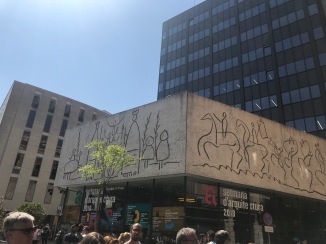Why am I talking about street art on a blog about being inspired by the Paris Bohemians. Two reasons… first is that I think that the bohemians, spurred by the invention of the camera, were the catalystic fathers (and occasional mothers) of all modern and contemporary art, and second it’s my blog, so basically I can flex the rules that made myself as I see fit.
I am staying in the El Ravel barrio of Barcelona. I think it might just be the street art capital of the universe. How can I not share the experience of being surrounded by so much inspired work? Every building is covered with art, usually only on the first floor, the rest being only used as a canvas occasionally by the very industrious. Much of it is generic tagging, but a good portion of it is brilliant artwork; everything from lowbrow art, to pop art, to classical portraiture. I really love the way that there seems to be respect for the most talented of the street artist. Tagging is layered on top of tagging, but if you see a piece of well done art in just about any style, even excellently rendered tagging, it is rare that anyone has disfigured it by tagging over it, instead it is left unspoiled with respect, that is not given even the most ancient buildings, save for Gaudi’s works, and a few others of national importance.
Perhaps many of these artist never give a second thought to the Paris Bohemians, but I can see the influence in the colors, the lines, the boldness, and the expression, and maybe most importantly the spirit of art as a rebellion.


















































